Shedding Light on the Green Glow: The Science and Magic of Uranium Glass
Uranium glass, also known as vaseline glass, has captivated collectors and enthusiasts with its unique properties and mesmerizing green glow. This remarkable type of glass has a fascinating history and has found its way into various aspects of our lives, from decorative items to scientific instruments. In this article, we will delve into the science and magic behind uranium glass, exploring its origins, composition, manufacturing process, and the allure it holds for collectors. Let’s shed some light on the glowing world of uranium glass.
Introduction
Uranium glass, first introduced in the early 19th century, is a type of glass that contains uranium oxide as a key component. It gained popularity for its vibrant green color, which is often enhanced by the glass’s unique ability to emit a fluorescent or phosphorescent glow when exposed to ultraviolet light. Let’s delve into the intriguing story of how uranium glass came to be.
The Discovery of Uranium Glass
The discovery of uranium glass is credited to the German chemist and physicist Wilhelm Röntgen, who accidentally stumbled upon its remarkable properties while conducting experiments in 1835. Röntgen observed that adding uranium oxide to glass resulted in a beautiful green color and a unique luminescence when exposed to sunlight.
Composition and Characteristics
Uranium glass owes its distinctive properties to the inclusion of uranium oxide (U3O8) in its composition. Typically, the uranium content ranges from 0.1% to 10% by weight, with the higher percentages producing a more intense green glow. This radioactive component gives the glass its characteristic fluorescence and phosphorescence.
Manufacturing Process
The manufacturing process of uranium glass involves the careful addition of uranium oxide to the glass mixture before it is heated and formed into the desired shape. The uranium oxide imparts the characteristic green color, and the glass is then annealed to ensure its stability and durability.

The Green Glow: Fluorescence and Phosphorescence
One of the most captivating aspects of uranium glass is its ability to fluoresce and phosphoresce under certain conditions. When exposed to ultraviolet light, such as a blacklight, the uranium atoms in the glass absorb the energy and re-emit it in the form of visible light, resulting in a beautiful green glow. Even after the UV light source is removed, uranium glass continues to emit light due to phosphorescence, creating a magical effect.
Collecting Uranium Glass
The allure of uranium-glass has captured the attention of collectors worldwide. With its vibrant green color and glowing properties, uranium-glass items have become highly sought after. Collectors often seek out antique pieces, such as vases, bowls, and figurines, as well as modern creations that incorporate uranium-glass elements.
Uranium Glass in Decor and Art
Beyond the realm of collecting, uranium-glass has made its way into various forms of decor and art. Its unique properties and striking green color have inspired artists and designers to incorporate it into stained glass windows, jewelry, and even contemporary sculptures. Uranium-glass adds an element of intrigue and enchantment to any artistic creation.

Uranium Glass in Scientific Instruments
The luminescent properties of uranium-glass have also found practical applications in scientific instruments. In the past, uranium-glass was utilized in Geiger-Müller counters, which detect and measure ionizing radiation. The glass’s ability to fluoresce and phosphoresce allows for the visualization of radiation levels, making it an invaluable tool in radiation detection.
Safety Concerns and Radiation Levels
Given its radioactive nature, concerns about the safety of uranium-glass often arise. However, it’s important to note that the radiation levels emitted by uranium-glass are generally considered to be low and pose no significant risk to human health. Nevertheless, it is recommended to handle uranium-glass with caution and avoid prolonged exposure.
Preserving and Caring for Uranium Glass
To preserve the beauty and integrity of uranium-glass, proper care is essential. It is advisable to store uranium glass items away from direct sunlight to prevent excessive fading. Regular cleaning with mild soap and water is sufficient, and polishing can be done with a soft cloth. By following these simple guidelines, uranium-glass can be enjoyed for generations to come.
The Future of Uranium Glass
As the appreciation for vintage and unique items continues to grow, the future of uranium-glass appears bright. Collectors and enthusiasts continue to seek out these mesmerizing pieces, and contemporary artists find new ways to incorporate uranium-glass into their creations. The allure of uranium-glass’s green glow and its intriguing history ensures that it will continue to captivate and fascinate for years to come.

Conclusion
Uranium-glass, with its enchanting green glow, is a testament to the fusion of science and art. From its accidental discovery to its role in scientific instruments and artistic creations, uranium glass has left an indelible mark on our culture. While enjoying the beauty of uranium-glass, it’s important to handle it responsibly and appreciate its unique qualities. So, whether you’re a collector, artist, or simply captivated by its allure, uranium-glass will continue to illuminate our lives with its magic and radiance.
FAQs
FAQ 1: Is uranium glass safe to use?
Yes, uranium-glass is generally considered safe to use. The radiation levels emitted by uranium-glass are low and do not pose a significant risk to human health. However, it is advisable to handle uranium glass with caution and avoid prolonged exposure.
FAQ 2: Can I find uranium glass in different colors?
While uranium-glass is most commonly associated with its vibrant green color, it can also be found in other hues, such as yellow and even pink. These variations are achieved by adding different chemicals to the glass mixture along with uranium oxide.
FAQ 3: How can I determine if a glass piece is made of uranium glass?
To determine if a glass piece is made of uranium glass, you can use UV light or black light. When exposed to UV light, uranium-glass will emit a distinct green glow. However, it’s important to exercise caution when handling UV lights and follow safety guidelines.
FAQ 4: Are uranium glass items highly sought after by collectors?
Yes, uranium-glass items are highly sought after by collectors. The unique properties, historical significance, and vibrant green glow make uranium glass a prized addition to any collection.
FAQ 5: Can I make my own uranium glass at home?
Creating uranium-glass at home is not recommended due to safety concerns. The handling of uranium oxide and the associated radiation risks should be left to professionals. It is best to appreciate and collect uranium-glass pieces that have been expertly manufactured and are available through reputable sources.
For more information on this regard, you may visit https://www.bidsquare.com/
Thank you for your visit https://info4you.in/

Leave a Reply